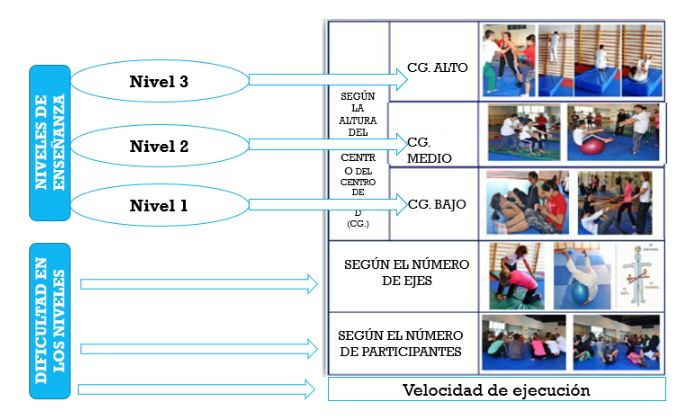JUSTIFICATION
FALLING AS A MOTOR SKILL
Regarding the established methodological progression, three levels of difficulty are proposed in the teaching of falls. These didactic levels related to teaching are organized based on the center of gravity's height, the number of axes involved in the fall's rotation, the number of participants involved in the fall, and, lastly, the speed of fall execution.

Figure. Didactic Levels of Falling Skill Instruction.
Below, the levels established based on the mentioned variables are detailed.
Level 1 or Initial Level:
At this level, the center of gravity's height is low (individual seated or just a few centimeters from the ground). During the fall, rotation occurs along a single axis, there may or may not be uncertainty, the fall is performed individually and/or in a group, and the execution speed is low.
Level 2 or Intermediate Level:
At this level, the center of gravity's height is medium (height defined by a knee flexion from approximately 90 degrees to the ground). During the fall, rotation can occur along one or two axes, there may or may not be uncertainty, the fall is performed individually and/or in a group, with a medium execution speed.
Level 3 or Advanced Level:
At this level, the center of gravity's height is high, meaning the individual is in a standing position or above the basic anatomical position (elevated from the ground). During the fall, rotation can occur along one or two axes, there may or may not be uncertainty, the fall is performed individually and/or in a group, and the execution speed is high.
Another aspect to consider when carrying out both analytical and playful activities for teaching falling skills is the level of uncertainty that can exist in each of them. You can go from a level of 0% uncertainty, where students decide when and how they will perform the action, i.e., when and how they will execute the falling skill, to a maximum uncertainty level of 100%, where it's the teacher or their peers who decide when they will perform the action of falling, i.e., when they will execute the falling skill unexpectedly, requiring them to apply the technique learned for that purpose.
Based on a holistic and comprehensive view of motor development, falling skill is considered a content of motor skills that should be learned by people at any stage of their lives, but it is children and adolescents who should focus on its teaching, allowing them to improve their health by promoting physical, psychological, and mental development, thus achieving physically literate youth.